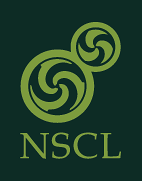ReA6 hosts first experiment
Following the commissioning of NSCL’s ReAccelerator facility ReA6 on 16 April, the NSCL stand-alone ReA6 user program began as scheduled on 12 May with its first experiment. Dr. Kelly Chipps from Oak Ridge National Laboratory (ORNL) conducted the experiment, which focused on next-generation neutron detectors.
In many cases, reactions involving neutrons are of interest to probe various nuclear physics problems, but neutron spectroscopy is tricky. Because neutrons don’t ionize material in the way that charged particles do, measuring their energy must be done indirectly. In order to get energy information from the neutrons emitted in a reaction of interest, two techniques can be used.
- The first is time-of-flight, where the neutron’s energy is related to the time of the first interaction inside the detector relative to a timing signal.
- The second is spectrum unfolding, where the energy can be extracted using a statistical likelihood method from the well-characterized light output of a deuterated scintillator.
The ORNL Deuterated Spectroscopic Array (ODeSA) is based on this latter technique. Chipps used a subset of the array in the FRIB Laboratory experiment (E20003) to test whether spectrum unfolding can be reliably used in inverse kinematics, where the rapidly changing neutron kinematics as a function of lab angle limit the achievable energy resolution. E20003 represents the first test of spectrum unfolding with an inverse kinematics beam.

The photo shows the setup on the general-purpose beamline in the new ReA6 vault. The ODeSA detectors are on the left, and the NEXT detectors are on the right, forming a semicircle around the spherical target chamber.
The University of Tennessee Neutron Detector with Xn Tracking (NEXT) array is based on the time-of-flight technique, but utilizes high segmentation to enable high-precision determination of the neutron’s time-of-flight and interaction position. This improves the ultimate energy resolution. NEXT has been used successfully in beta-delayed neutron measurements, but E20003 represented its first test for use in reaction studies.
Chipps conducted the E20003 experiment using NSCL’s general-purpose beamline in the new ReA6 vault. The ODeSA detectors and the NEXT detectors formed a semicircle around the spherical target chamber. E20003 tested these new detector arrays to better understand how they will perform for future neutron spectroscopic studies using reaccelerated beams from FRIB.
ReA6 is the upgraded ReAccelerator facility at NSCL and the Facility for Rare Isotope Beams. It will provide broader opportunities for nuclear physics experiments with higher beam energies than the previous ReA3.



